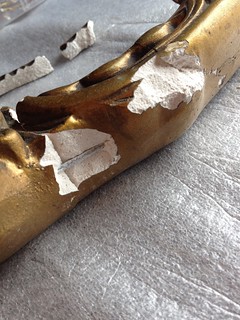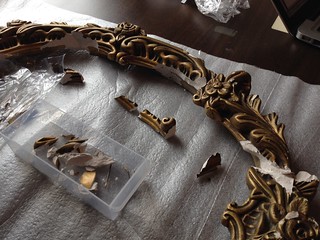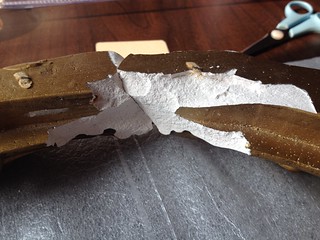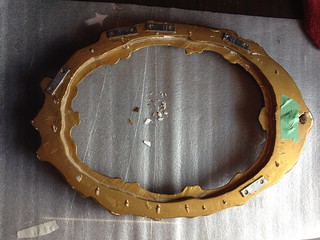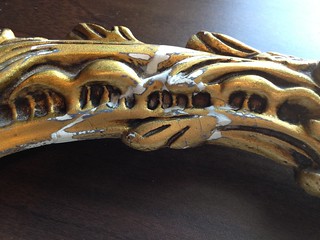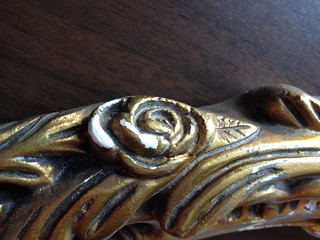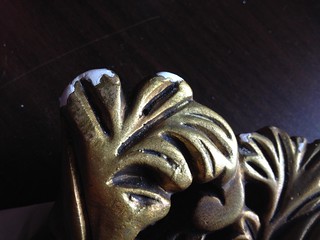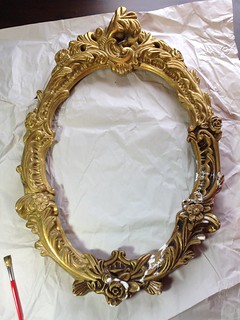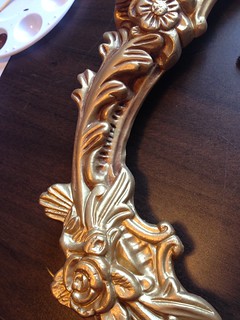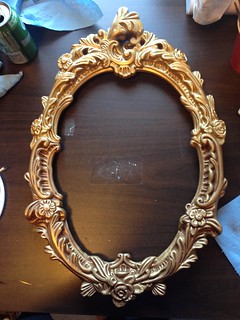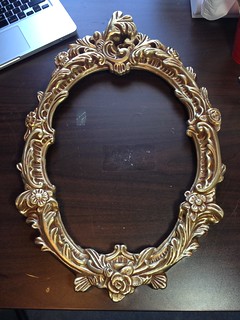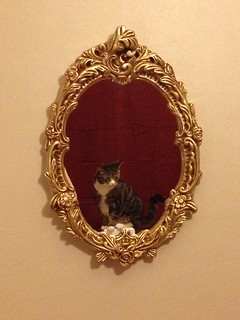Back in 2011, I bought a plaster mirror off eBay for £26. It was badly packed by the seller, however, and arrive with several cracks and chips. I was gutted, but kept it anyway. In 2013, it got shipped over to the US, during which process our moving company broke it even further. When I looked at it, I wasn’t really sure it could ever be saved: Too many chunks and chips broken off, and five major fractures. I kept it anyway, just in case.
Last August, I decided to see what I could do to save it. All I had to do was glue it all back together, fill the holes and paint it, right?
I read around about what sort of glue to use, and one recommendation was Fabri-Tac, a fabric glue, which dries relatively quickly but stays workable for long enough to allow positioning. It also works well with plaster, forming a thin layer which doesn’t make the joint thicker than it should be. Gluing all the little bits and chips back was actually a lot of fun, a three dimensional jigsaw puzzle.
So that would work for gluing on the bits that had broken off, but there were five fractures that would need a little bit more strength than I thought Fabri-Tac could provide. However, there’s also a metal hoop that is set into the plaster, so I couldn’t move the broken sections apart to get the glue in between them. The only thing I could think of was using a fast-drying (5-minute) epoxy to glue a metal bars to the back to act as a brace, and if I could, dribble some Fabri-Tac down the fracture to provide extra strength.
Once everything was put back together, barring the few chips in the middle of the above photo that I couldn’t find the home for, it was time to fill in the cracks and gaps. At first I thought it would be easiest to use filler, or what Americans call spackle, but it turned out to be a major error – whilst the filler went on easily, it dried soft, not hard. Turned out to be a vinyl filler that was entirely not suitable for this project. Instead, I bought proper plaster of paris, which will dry hard.
Now, plaster of paris is a really squirly material to work with, and it took me ages to figure out how best to use it. Mixing it thick and then trying to smear it on like filler totally did not work as it didn’t even begin to adhere to the bare plaster. Instead, I mixed it really thin, and then painted it on in layers using a small brush. It thickens very quickly, though, but a little extra water in the mix keeps it workable. You do have to clean the brush off regularly though, otherwise you end up with a stick with a blob of plaster on the end.
Eventually, I got everything filled, and then I sanded it down with fine sandpaper.
Next, it was time to paint. This is where my impatience really got the better of me. Instead of doing research, I just bought a couple of ‘metallic gold’ acrylic paints, picked a shade I liked and got to painting.
The result was plasticky, to say the least. Although it looked half-decent when not in direct light, the colour deepened by the shadows, in bright sunlight it looked awful.
I had bought some gold-coloured metallic powder for another project, so thought I’d mix some of that into some clear acrylic gloss varnish to get a richer finish. It was… ok. I tried again, but added some burnt sienna to give it a slightly darker colour, and see if that worked better. It sort of did, but it still looked more like plastic than gold leaf. It was tolerable, I guess, but not really what I wanted.
After a break, due to Christmas and the like, I decided this weekend to have a go at antiquing it, to see if that would save it. Mixing burnt sienna with burnt umber in a 1:2 ratio gave a nice, reddish-brown colour, which I painted into the recesses with a small paintbrush, then took most of it off again with a stiff-bristled brush, and wiped the excess off the highlight areas with a cloth. That made a huge difference, giving the frame much more depth.
In the top photos, the top part of the frame has been antiqued, and in the bottom photo, the bottom part has been done.
The antiquing certainly helped, but it still wasn’t quite right. Luckily, for Christmas I was given some Liquid Leaf, which gets the best reviews for of any of the metallic paints. Whist it doesn’t give a finish as smooth as real leaf, it does do a good job. I decided to add that to the highlights. Finally, that gave a finish I was happy with.
And once the mirror was in and it was hung on the wall at the bottom of the stairs, Grabbity could sit on the newel post to admire herself:
The finish is quite a bit lighter in tone than the original, but I prefer that. Overall, I’m really pleased about how it came out, though in retrospect I’d do things a bit differently with the painting. What I should have done was:
- Seal the bare plaster with an acrylic sealant.
- Paint the whole thing with Liquid Leaf.
- Seal with gloss acrylic sealant (I haven’t been able to seal this frame, because of the order I did it all in, so the Liquid Leaf may tarnish over time)
- Antique with the acrylic burnt sienna/umber mix, but water it down a bit and make sure not to get it on the highlights. If necessary, do it in layers rather than try to do it all at once. (Also, mix enough for the whole frame, otherwise you might have issues matching the colour.)
That said, I have a totally different plan for my next mirror, which is much smaller, but needs just as much love.
{ Comments on this entry are closed }

